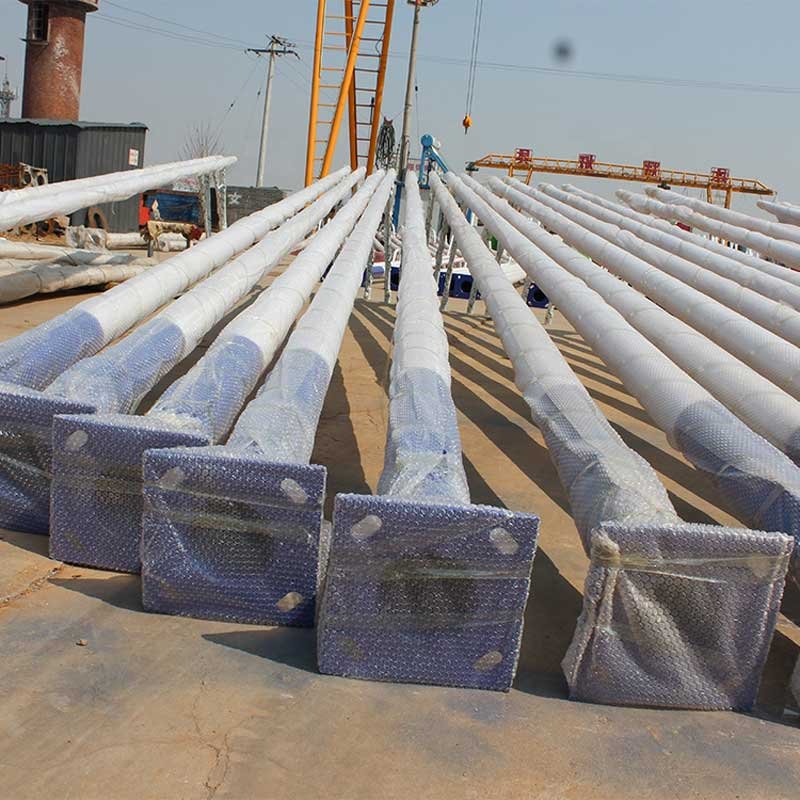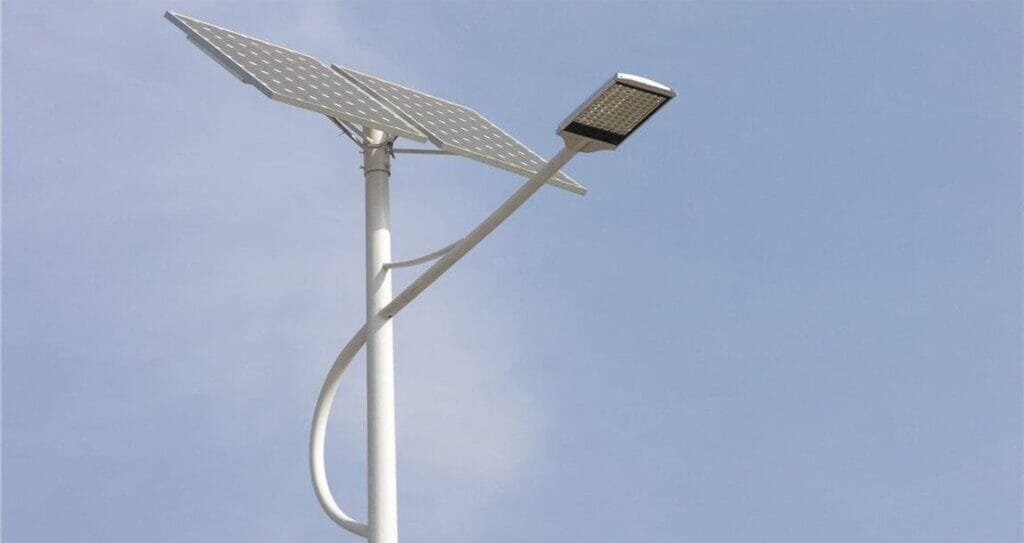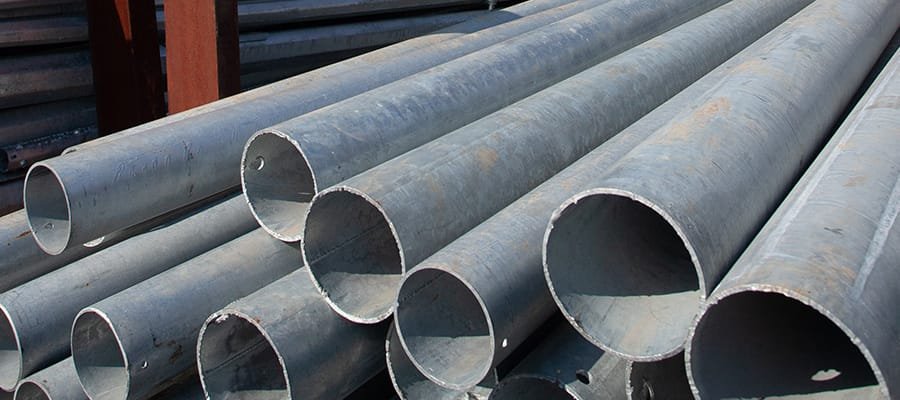Coastal environments are beautiful—but they are brutal on infrastructure, especially anything made of metal.
Galvanized poles can perform well in coastal settings with the right design, coatings, and maintenance—but they are not always the best choice.
Many contractors and planners underestimate salt air’s corrosive power. In this article, I’ll break down how galvanized poles really perform near the ocean and what materials you should consider instead.
What Is a Galvanized Pole?
If you’re managing a coastal lighting project, you’ve probably seen “galvanized” pop up as a common spec.
A galvanized pole is a steel pole coated with zinc through hot-dip galvanization, offering corrosion resistance in outdoor settings.
Definition of Galvanized Pole
Hot-dip galvanization is a process where steel is dipped into molten zinc. The zinc bonds to the steel, forming a protective layer that shields it from corrosion. This protection is both barrier-based and sacrificial: the zinc corrodes before the steel does.
Compared to non-galvanized poles, the galvanized version lasts longer in most outdoor environments, especially where moisture is present.
Why Galvanized Poles Are Common in Outdoor Projects
- Cost-effective upfront
- Widely available
- Easy to fabricate and install
- Strong enough for most wind loads
Most street lights and highway lighting poles are galvanized for these reasons. For inland or moderately humid climates, they work very well.
Challenges of Coastal Environments for Light Poles?
Near the ocean, standard materials degrade fast—even galvanized ones—if you're not careful.
Salt, moisture, and wind create a perfect storm for corrosion, especially for exposed metal poles.
How Salt Air and Moisture Affect Light Poles
Salt accelerates rust because it carries water deep into the metal surface. It also conducts electricity, speeding up electrochemical corrosion. When wind-driven spray hits a pole daily, even high-quality coatings wear out fast.
Typical Coastal Damage Examples
- Pitting and blistering on pole surfaces
- Rust bleed from seams and base plates
- Coating delamination
- Structural weakening at weld joints
I’ve seen poles fail in less than 8 years because they weren’t designed for marine air. That’s not just costly—it’s dangerous.
Factors to Consider for Coastal Light Pole Installations
| Factor | Why It Matters |
|---|---|
| Wind Load | Coastal winds can exceed design standards |
| UV Exposure | Degrades coatings and finishes faster |
| Salt Spray Distance | Poles within 500m of ocean are high risk |
| Foundation Type | Corrosion starts underground if unsealed |
You must combine structural engineering with corrosion management in these zones.
Is a Galvanized Pole Good for Coastal Projects?
The real question isn’t just “is it good?”—it’s “how long will it last, and how much will it cost to maintain?”
Galvanized poles provide moderate corrosion resistance in coastal areas but require coatings and maintenance to stay effective.
Corrosion Resistance of Galvanized Poles in Coastal Areas
The zinc layer works well—but salt shortens its life. Studies show:
- 20–25 years lifespan in severe exposure zones if maintained
- Zinc wears unevenly, exposing steel if not recoated
- Splash zones (e.g., docks) degrade fastest
Galvanized poles are not maintenance-free in coastal air. Even the best zinc layer will wear down under constant salt spray.
Pros and Cons of Using Galvanized Poles on the Coast
| Pros | Cons |
|---|---|
| Affordable upfront cost | Shorter lifespan in splash/marine zones |
| Readily available | Zinc layer erodes quickly near saltwater |
| Acceptable for inland/coastal hybrid zones | Risk of internal corrosion in hollow poles |
| Easy to install | Needs additional coating for long-term use |
Best Light Pole Materials for Coastal Projects?
In salt-rich environments, some materials simply hold up better than others.
Fiberglass, aluminum, and stainless steel often outperform galvanized steel in coastal projects.
Galvanized Pole vs Stainless Steel Pole
| Feature | Galvanized Steel | Stainless Steel |
|---|---|---|
| Corrosion Resistance | Moderate | Excellent (esp. 316 grade) |
| Maintenance Needs | Medium to High | Low |
| Cost | Low | High |
| Weight | Heavy | Heavy |
Stainless is ideal near the shore but is costly. Use it for key installations like walkways or landmarks.
Galvanized Pole vs Aluminum Pole
| Feature | Galvanized Steel | Aluminum |
|---|---|---|
| Corrosion Resistance | Moderate | Very good (especially anodized) |
| Weight | Heavy | Light |
| Grounding Needs | Yes | Non-conductive options |
| Cost | Lower | Medium |
Aluminum resists salt air well and is easier to transport. We often recommend it in coastal cities across West Africa.
Galvanized Pole vs Fiberglass Pole
| Feature | Galvanized Steel | Fiberglass |
|---|---|---|
| Corrosion Resistance | Moderate | Excellent |
| Weight | Heavy | Very light |
| Impact Resistance | High | Medium |
| UV Resistance | Medium | High |
Fiberglass is best for low-impact areas like parks or residential streets. It doesn’t corrode or rust—ever.
How to Make Galvanized Poles Last Longer in Coastal Environments?
If galvanized is your only option, there are ways to make it last.
Use protective coatings and set up a regular maintenance plan to extend your galvanized pole's lifespan.
Use of Additional Coatings or Paint on Galvanized Poles
Adding a second layer of protection is called a duplex system.
| Coating Type | Benefit |
|---|---|
| Epoxy Primer | Strong base coat |
| Polyurethane Top Coat | UV and salt resistance |
| Powder Coating | Even finish, good durability |
This can increase lifespan by 1.5x the sum of galvanization and paint life.
Regular Maintenance Tips for Galvanized Poles in Salt Air
- Rinse poles every 2–3 months with clean water
- Inspect for rust or peeling coatings quarterly
- Touch up coatings as soon as wear appears
- Seal handholes and bases to prevent water ingress
Salt accumulates fast. I recommend contractors set up a yearly maintenance contract with local clients.
Expert Recommendations: When to Use or Avoid Galvanized Poles in Coastal Projects?
Sometimes it’s okay to use galvanized poles—sometimes it’s not.
Use galvanized poles when salt exposure is minimal and budgets are tight. Avoid them in marine or splash zones.
When to Use
- Inland cities with occasional salt air
- Projects where poles can be easily replaced
- Temporary installations
When to Avoid
- Waterfront walkways or ports
- High-salt zones within 500m of the ocean
- Locations with no access to regular maintenance
When long-term performance matters more than cost, I recommend aluminum or fiberglass. In extreme salt conditions, galvanized just doesn’t hold up.
FAQs About Galvanized Poles in Coastal Areas
How long does a galvanized pole last by the ocean?
Typically 8–15 years near the shoreline, depending on maintenance.
What’s the best coating for galvanized steel in marine environments?
A duplex system using epoxy and polyurethane top coats.
Are there building codes that restrict galvanized poles near the ocean?
Some regions have guidelines discouraging their use in marine splash zones—check local standards.
Conclusion
Galvanized poles are good—but not great—for coastal projects. If your installation is within heavy salt spray zones, I recommend aluminum, fiberglass, or stainless steel. But if the site is inland or you have limited budget, a galvanized pole with added coating and maintenance can still perform well. Think long-term durability, not just upfront savings.





